|
A Quilting Cornucopia
Source: Wikipedia
“To our grandmothers quilt making meant social pleasure as well as necessary toil, and to their grandmothers it gave solace during long vigils in pioneer cabins. The work of the old-time quilters possesses artistic merit to a very high degree. While much of it was designed strictly for utilitarian purposes – in fact, more for rugged service than display, yet the number of beautiful old quilts which these industrious ancestors have bequeathed to us is very large.”
- Marie D. Webster, Hoosier quilter, author of
Quilts - Their Story and How to Make Them

Quilting traditions are particularly prominent in the United States, where the necessity of creating warm bedding met the paucity of local fabrics in the early days of the colonies. Imported fabric was very expensive, and local homespun fabric was labor-intensive to create and tended to wear out sooner than commercial fabric. It was essential for most families to use and preserve textiles efficiently. Saving or salvaging small scraps of fabric was a part of life for all households.
Small pieces of fabric were joined together to make larger pieces, in units called “blocks.” Creativity could be expressed in the block designs, or simple “utility quilts,” with minimal decorative value, could be produced. Crib quilts for infants were needed in the cold of winter, but even early examples of baby quilts indicate the efforts that women made to welcome a new baby.
Quilting was often a communal activity, involving all the women and girls in a family or in a larger community.
A key component that defines a quilt is the stitches holding the three layers together—the quilting. Quilting, typically a running stitch, can be achieved by hand or by sewing machine.
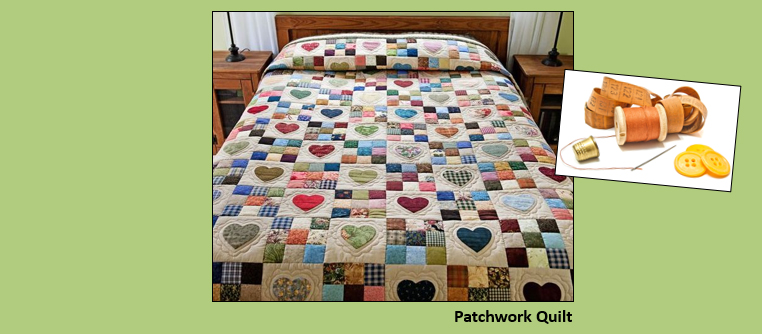
Patchwork & Piecing
Patchwork or “pieced work” is a form of needlework that involves sewing together pieces of fabric into a larger design. The larger design is usually based on repeating patterns built up with different fabric shapes (which can be different colors). These shapes are carefully measured and cut, basic geometric shapes making them easy to piece together.
Patchwork blocks are pieced squares made up of colored shapes that repeat specific shapes to create patterns within the square or block, of, say, light and dark, or contrasting colors (a motif). The blocks can all repeat the same pattern, or blocks can have several different patterns. The patchwork blocks are typically around 8” - 10” square (20 cm to 25 cm). They are sewn together in stacked rows to make a larger composition. Often, strips of contrasting fabric form a lattice that separates the patchwork blocks from each other.
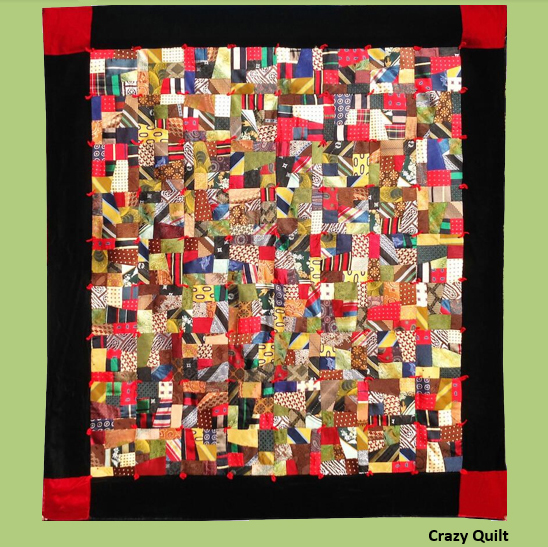
Crazy Quilts
A unique form of patchwork quilt is the Crazy Quilt. These quilts are so-named because their pieces are irregular. The patchwork pieces are stitched together forming “crazy” or non-repeat, asymmetric compositions.
These were originally refined, luxury items. Geometric pieces of rich fabrics were sewn together, and highly decorative embroidery was added. Such quilts were often effectively samplers of embroidery stitches and techniques, displaying the development of needle skills of those in the well-to-do late 19th-century home. They were show pieces, not used for warmth, but for display. They often took years to complete.
Charm Quilts
A patchwork quilt with no two pieces alike.
Oddfellow Quilts
Like a Charm Quilt, but one that actually has two fabric pieces out of the hundreds that match. Like a puzzle, it’s a challenge to find them.
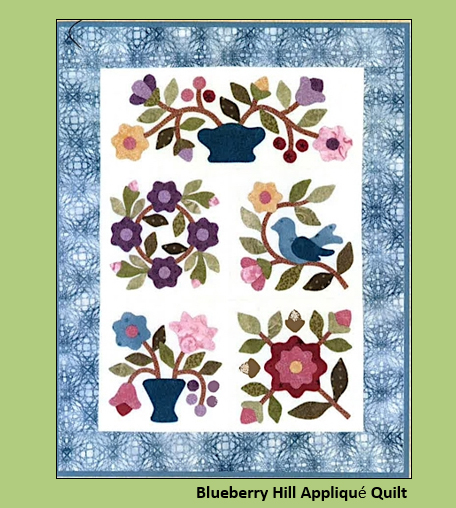
Appliqué Quilts
There are several different appliqué techniques and styles. In needle-turn appliqué, the raw edges of the appliquéd fabric are tucked beneath the design to minimize raveling or damage, and small hand stitches are made to secure down the design. The stitches are made with a hem stitch, so that the thread securing the fabric is minimally visible from the front of the work.
There are other methods to secure the raw edge of the appliquéd fabric, and some people use basting stitches, fabric-safe glue, freezer paper, paper forms, or starching techniques to prepare the fabric that will be applied prior to sewing it on. Supporting paper or other materials are typically removed after the sewing is complete. The ground fabric is often cut away from behind, after the sewing is complete, in order to minimize the bulk of the fabric in that region.
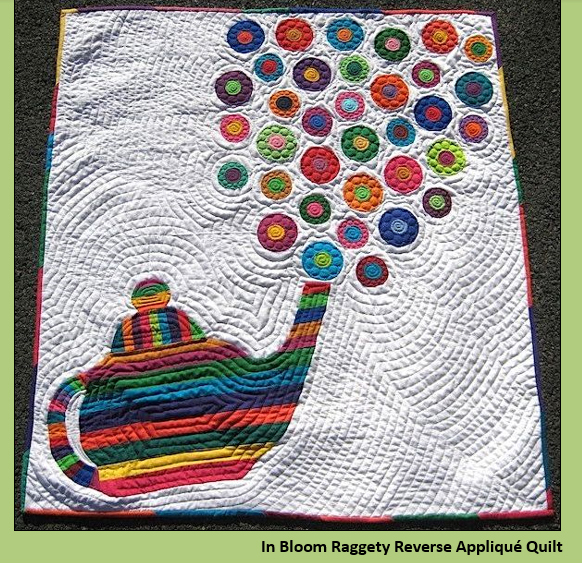
Reverse Appliqué
Reverse appliqué is a sewing technique where a ground fabric is cut, another piece of fabric is placed under the ground fabric, the raw edges of the ground fabric are tucked under, and the newly folded edge is sewn down to the lower fabric. Stitches are made as inconspicuous as possible. Reverse appliqué techniques are often used in combination with traditional appliqué techniques, to give a variety of visual effects.
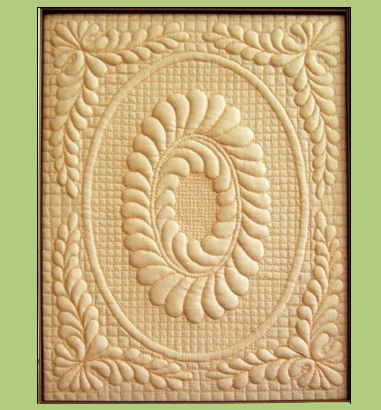
Trapunto Quilts
Trapunto is a sewing technique where two layers of fabric surrounding a layer of batting are quilted together, and then additional material is added to a portion of the design to increase the profile of relief as compared to the rest of the work. The effect of the elevation of one portion is often heightened by closely quilting the surrounding region, to compress the batting layer in that part of the quilt, thus receding the background even further.
Cording techniques may also be used, where a channel is created by quilting, and a cord or yarn is pulled through the batting layer, causing a sharp change in the texture of the quilt. For example, several pockets may be quilted in the pattern of a flower, and then extra batting pushed through a slit in the backing fabric (which will later be sewn shut). The stem of the rose might be corded, creating a dimensional effect. The background could be quilted densely in a stipple pattern, causing the space around the rose bush to become less prominent.
These techniques are typically executed with whole cloth quilts, and with batting and thread that matches the top fabric.
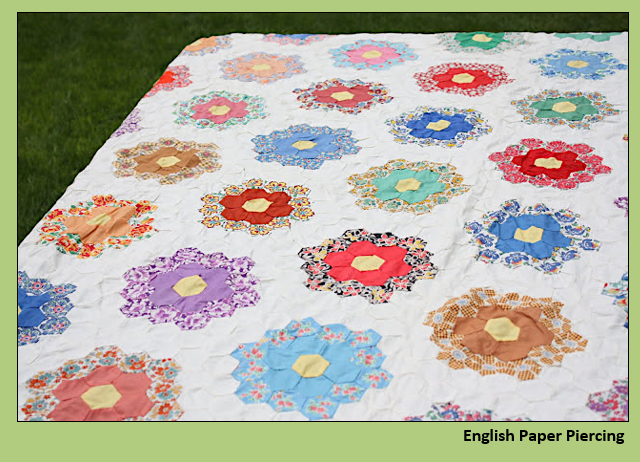
English Paper Piecing Quilts
English paper piercing is a hand-sewing technique used to maximize accuracy when piecing complex angles together. A paper shape is cut with the exact dimensions of the desired piece. Fabric is then basted to the paper shape. Adjacent units are then placed face to face, and the seam is whipstitched together. When a given piece is completely surrounded by all the adjacent shapes, the basting thread is cut, and the basting and the paper shape are removed.
Memory Quilts
Memory quilts are a great way to remember or celebrate your family history, the life of a loved one, or an important event in your life.
Christmas Quilts
Everybody loves the festive season and what better way to celebrate it than with your very own Christmas-themed quilt.
American Civil War Quilts
Women played a fundamental role in the American Civil War effort by making quilts for the soldiers. Read about this unique style of quiltmaking that emerged during these difficult times.
Baby Quilts
Every baby deserves to have his or her own quilt or blanket. They are usually smaller in size. Baby quilts can be used during a child’s early years and kept as a memento when they are older.
Next: Quilt Styles
|
|
